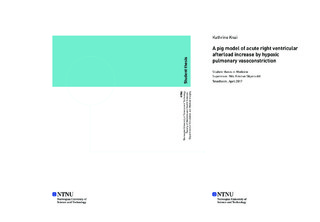| dc.description.abstract | Background: The aim of this study was to construct a non-invasive model for acute right ventricular afterload increase by hypoxic pulmonary vasoconstriction. Intact animal models are vital to improving our understanding of the pathophysiology of acute right ventricular failure. Acute right ventricular failure is caused by increased afterload of the right ventricle by chronic or acute pulmonary hypertension combined with regionally or globally reduced right ventricular contractile capacity. Previous models are hampered by their invasiveness; this is unfortunate as the pulmonary circulation is a low-pressure system that needs to be studied in closed chest animals. Hypoxic pulmonary vasoconstriction is a mechanism that causes vasoconstriction in alveolar vessels in response to alveolar hypoxia. In this study we explored the use of hypoxic pulmonary vasoconstriction as a means to increase the pressure load on the right ventricle.
Results: Pulmonary hypertension was induced by lowering the FiO2 to levels below the physiological range in eight anesthetized and mechanically ventilated pigs. The pigs were monitored with blood pressure measurements and blood gases. The mean pulmonary artery pressures (mPAP) of the animals increased from 18.3 (4.2) to 28.4 (4.6) mmHg and the pulmonary vascular resistance (PVR) from 254 (76) dyns/cm5 to 504 (191) dyns/cm5 , with a lowering of FiO2 from 0.30 to 0.15 (0.024). The animals’ individual baseline mPAPs varied substantially as did their response to hypoxia. The reduced FiO2 level yielded an overall lowering in oxygen offer, but the global oxygen consumption was unaltered.
Conclusions: We showed in this study that the mPAP and the PVR could be raised by approximately 100% in the study animals by lowering the FiO2 from 0.30 to 0.15 (0.024). We therefore present a novel method for minimally invasive (closed chest) right ventricular afterload manipulations intended for future studies of acute right ventricular failure. The method should in theory be reversible, although this was not studied in this work.
Keywords: Acute right ventricular failure, Pulmonary hypertension, Hypoxic pulmonary vasoconstriction | nb_NO |
